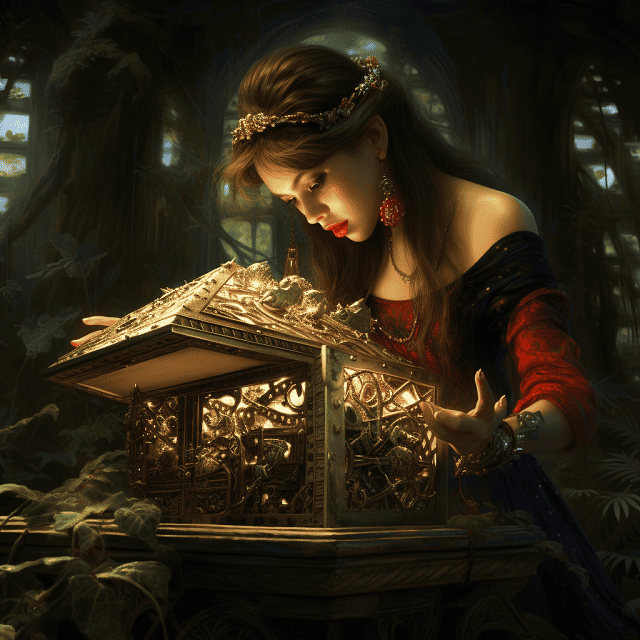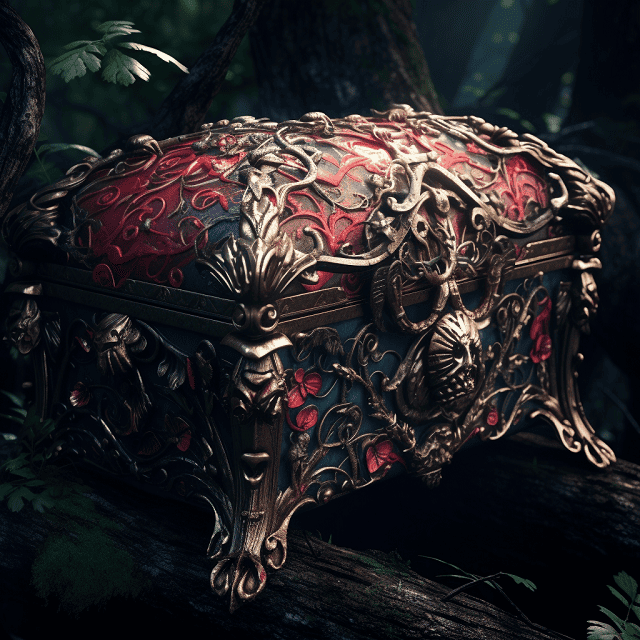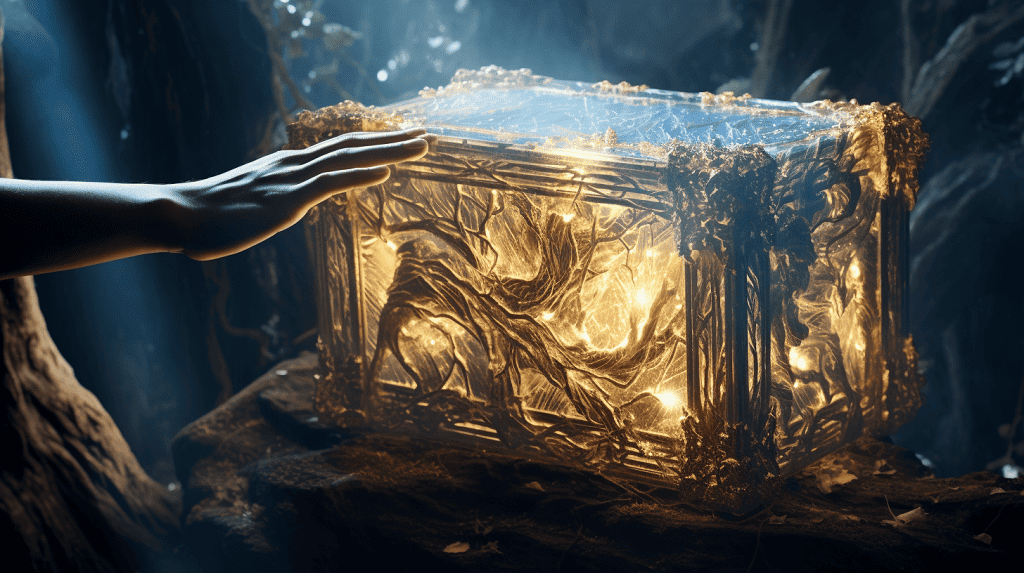Ever wondered about the origins of ‘Pandora’s Box’? You’re about to dive into an intriguing journey through time. We’ll unmask this infamous Greek myth, explore its symbolism, and uncover its impact on modern literature. But be warned: just like Pandora herself, you might find what’s inside more compelling than you’d imagined. So, buckle up and let’s delve into the enigma wrapped in mystery that is Pandora’s Box.
The Mythology Behind Pandora’s Box
It’s interesting to compare the mythology behind Pandora’s Box to the One Ring in Lord of the Rings, both carry a curse and cause chaos once unleashed. You see, Pandora’s Box originates from Greek mythology. It wasn’t actually a box but a jar given to Pandora, the first woman on Earth created by Zeus who was curious just like you.
Zeus gifted her this ‘box’ as part of his plan for revenge against Prometheus for stealing fire from heaven. Inside it were all evils that could plague mankind – sickness, death, turmoil; everything except hope that remained at its bottom. When she couldn’t contain her curiosity any longer, she opened it, thus releasing these evils into the world.
Much like how Frodo is entrusted with the Ring in Tolkien’s epic fantasy series. The One Ring carries immense power and evil within it as well, forged by Sauron in Mount Doom to control all others. Its corrupting influence causes chaos and destruction throughout Middle-earth when unleashed.
In both myths there’s an emphasis on willpower and resistance against temptation – Pandora succumbs to her curiosity while Frodo struggles against the allure of ultimate power. These narratives delve deep into human nature’s inherent flaws – our insatiable curiosity and unquenchable thirst for power.
It’s fascinating how despite centuries apart and different cultural contexts, these two legends mirror each other strikingly in their exploration of human weaknesses through symbolic objects carrying curses or chaotic powers. As you analyze them further, they offer rich insights into humanity’s enduring struggle with temptation and consequence.
The Symbolism in Pandora’s Box
You’re probably curious about the symbolism hidden within this ancient artifact, aren’t you? Pandora’s Box, a renowned symbol from Greek mythology, is fraught with implications that echo through centuries of literature and philosophy.
Let me break down the key elements for you:
- The Box Itself: The box represents curiosity and the human condition’s inherent desire to explore and understand. Much like Eve in the Garden of Eden or Bilbo Baggins with his irresistible Ring in “Lord of the Rings,” it signifies our natural inclination towards discovery often leads us into danger.
- Pandora: She embodies naivety, innocence, and humanity’s perpetual struggle between obedience and curiosity. Her action reflects how we often act impulsively without considering consequences.
- The Evils Released: They are symbolic representations of all earthly suffering – sickness, death, vice – problems created by ourselves when we overstep boundaries.
- Hope: This was also trapped inside Pandora’s Box but wasn’t released until last after all the evils had escaped. This provides a glimmer of optimism amidst despair; even if we unleash havoc due to our actions, there is always hope for redemption.
Examining these symbols offers insight into human nature as perceived by ancient Greeks – a balance between curiosity leading to potential ruin or enlightenment paired with an enduring sense of hope for redemption despite our flaws.
The tale serves as a warning about overreaching ambition while simultaneously providing solace through its promise that hope persists even in direst situations. So next time you hear reference to ‘Pandora’s box’, remember it’s not just about doom and gloom but also resilience in face of adversity.

Pandora’s Box in Popular Culture
Now, let’s dive into how this ancient tale has left its mark on popular culture, shall we? You’re probably aware of the term ‘Pandora’s Box‘ thrown around casually in conversations or seen it used metaphorically in literature and film. But have you ever wondered about the depth of its influence and symbolism?
The usage of Pandora’s Box as a trope is widespread across various forms of media. Take for example, the world-renowned epic fantasy series ‘Lord of The Rings’. You might not immediately see the correlation, but look closer. The One Ring parallels Pandora’s box – an object that unleashes immense chaos when opened or used.
In literature too, you’ll see this concept crop up frequently. It serves as a potent allegory for human curiosity and its sometimes disastrous consequences. From Mary Shelley’s ‘Frankenstein’ to H.P Lovecraft’s tales of cosmic horror, it’s evident that Pandora’s Box has been a cornerstone motif.
Moreover, it’s also permeated into science fiction narratives like Ray Bradbury’s iconic short story ‘A Sound Of Thunder’. Here, time travel becomes the metaphorical box opening up disastrous ripple effects.
Even modern pop culture isn’t immune from this ancient mythos. Television shows such as Doctor Who and Supernatural have episodes where similar themes are explored; unleashing something unknowingly that wreaks havoc.
You see now how deeply entrenched this ancient tale is in our collective consciousness? It underscores our fascination with exploring the unknown despite potential peril—a testament to how enduring and pervasive myths can be within society’s cultural fabric. That concludes our exploration on Pandora’s Box in popular culture.
The Impact of Pandora’s Box on Modern Literature
We’ll find that modern literature often mirrors ancient tales, using metaphors like the cursed artifact from Greek mythology to convey themes of curiosity and its potential for disaster. You can see this trend clearly in how Pandora’s Box has influenced several contemporary works. The symbol of a box containing all the world’s evils is so potent, it resonates even today.
- “Harry Potter” by J.K. Rowling: In these novels, you’ll spot similarities between Pandora’s Box and the Horcruxes Voldemort creates to ensure his immortality. Like Pandora opening her box out of curiosity, characters are tempted to interact with these objects despite their destructive potential.
- “The Lord of The Rings” by J.R.R Tolkien: This trilogy presents another instance where ambition leads to calamity, similar to Pandora’s tale. The “One Ring,” just like the mythical box, is an object that arouses curiosity but brings about disaster when used.
- “His Dark Materials” by Philip Pullman: Here again, you’ll find echoes of Pandora’s Box in the Alethiometer and Subtle Knife – instruments that promise knowledge but at great cost.
- Stephen King’s various works: King frequently employs cursed artifacts whose use results in dire consequences reminiscent of Pandora’s tale – such as Leland Gaunt’s shop items in “Needful Things.”
The Moral Lessons From Pandora’s Box
It’s worth noting how the moral lessons derived from these ancient tales significantly influence modern literature. When you delve into the story of Pandora’s Box, you’ll find lessons about curiosity, consequences and hope that still resonate today.
One such example is J.R.R. Tolkien’s “The Lord of the Rings.” Just as Pandora was unable to resist opening the box despite knowing she shouldn’t, Frodo too had to grapple with his overwhelming desire to use the ring’s power, despite understanding its potential destructive effects.
In both cases, their actions led to disastrous outcomes. However, they also revealed essential truths: our choices bear consequences; our actions impact others; and even in darkness, there is always a glimmer of hope.
This table further illustrates these concepts:
| Moral Lesson | Pandora’s Box | The Lord of the Rings |
|---|---|---|
| Curiosity | Pandora opens box | Frodo uses ring |
| Consequence | Unleashes evils | Ring corrupts |
| Hope | Left in box | Samwise’s loyalty |
These narratives remind us that we need to be mindful of our inherent curiosity as it can sometimes lead us astray. Simultaneously though, they assure us that hope remains even amidst chaos and despair.
The Interpretations of Pandora’s Box Over Time
Over time, interpretations of this ancient tale have varied greatly. You’ll find that Pandora’s Box is not just a simple story with a straightforward moral lesson; instead, it has evolved and morphed through different cultures and ages, each rendering offering its unique insights.
Here are four key interpretations:
- The Classical Interpretation: Originating in Greek mythology, the tale was initially seen as a cautionary story about curiosity leading to unforeseen consequences. Pandora’s action of opening the box released all evils into the world but also hope, suggesting that even in dire situations there lies potential for optimism.
- Christian Interpretation: This version saw Pandora’s box as an allegory for Eve’s temptation in the Garden of Eden. It’s interpreted as humanity’s initial fall from grace due to disobedience and yielding to temptation.
- Romantic Interpretation: In some romanticized versions, Pandora’s act is viewed as necessary for human progression – a painful yet indispensable step towards enlightenment.
- Modern Pop Culture Interpretation: Nowadays you often see ‘Pandora’s Box’ used metaphorically in literature and media (like Tolkien’s ‘Lord of The Rings’) to denote any source of great and unexpected troubles or problems.
Each interpretation offers distinct perspectives on human nature – our inherent curiosity, capacity for both good and evil, resilience in face of hardships and ability to cope with change or adversity. These shifting interpretations over time reflect evolving societal values and understanding – demonstrating that ancient tales like ‘Pandora’s Box’ continue to resonate deeply within us due to their timeless themes which remain relevant across centuries.

Frequently Asked Questions
How Does the Concept of Pandora’s Box Compare to the ‘One Ring’ in ‘The Lord of the Rings’ Series?”
You’re comparing the ‘One Ring’ from ‘The Lord of the Rings’ series to an undisclosed concept. The ‘One Ring,’ crafted by Sauron, has a corruptive power that’s irresistible. It instills in its bearer an insatiable desire for control and dominion, much like the allure of unchecked power can be tantalizing yet destructive. This resembles a certain Greek mythological story, which you might recognize once we introduce it into our discussion.
Has There Been Any Crossover Between the Story of Pandora’s Box and Other Popular Fantasy Franchises Like ‘The Lord of the Rings’?”
You’re asking if there’s any crossover between popular fantasy franchises like ‘The Lord of the Rings’ and other mythologies, correct? Well, while Tolkien did draw heavily from various mythologies to create his world, there isn’t a direct correlation with the story of Pandora’s Box. His work stands unique and independent, though it does feature common themes such as temptation and catastrophic consequences, familiar in many myths.
Are There Any References to Pandora’s Box in J.R.R. Tolkien’s ‘The Lord of the Rings’?”
You’re asking about references to a specific mythological element within J.R.R. Tolkien’s “The Lord of the Rings” series. It’s important to note that while Tolkien did incorporate various mythologies into his works, there aren’t any explicit mentions or allusions to Pandora’s Box in his iconic trilogy. His narratives are deeply rooted in his own imaginations and extensive knowledge of Norse and Old English myths, rather than Greek mythology.
What Are Some Key Differences Between the Moral Lessons From Pandora’s Box and Those in ‘The Lord of the Rings’?”
In Tolkien’s ‘The Lord of the Rings’, you’ll find moral lessons subtly woven into the narrative. Unlike some tales, these lessons often focus on bravery, friendship, and resisting temptation. They differ significantly from those in other stories as they don’t rely on a single act of disobedience leading to unforeseen consequences. Instead, they emphasize personal growth through facing adversity and making hard choices. It’s quite a diverse contrast when you omit Pandora’s Box from the comparison.
How Has the Interpretation of Pandora’s Box Over Time Compared to the Interpretation of ‘The Lord of the Rings’?”
You’re examining how ‘The Lord of the Rings’ interpretation has evolved over time. It’s seen shifts from purely escapist fantasy to deep allegorical readings on war, power, and morality. Unlike static ancient myths, its meaning adapts with societal changes. However, it’s essential to remember that Tolkien himself resisted allegorical readings in favor of applicability, allowing each reader their unique understanding based on personal context.
Conclusion
So, you’ve journeyed through the myth of Pandora’s Box, delving into its symbolism and cultural impacts. You’ve seen how it’s shaped literature, influencing narratives like Tolkien’s ‘The Lord of The Rings’. Isn’t it fascinating how this ancient tale still teaches us about temptation and consequences? Thus, Pandora’s Box remains forever relevant – a timeless reminder that curiosity can often lead to unintended outcomes.

